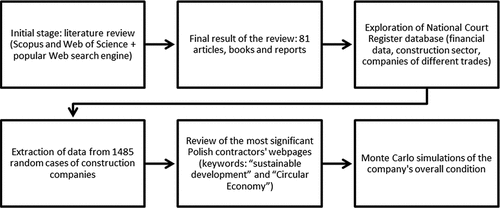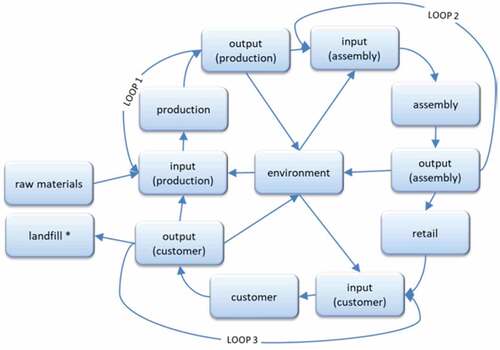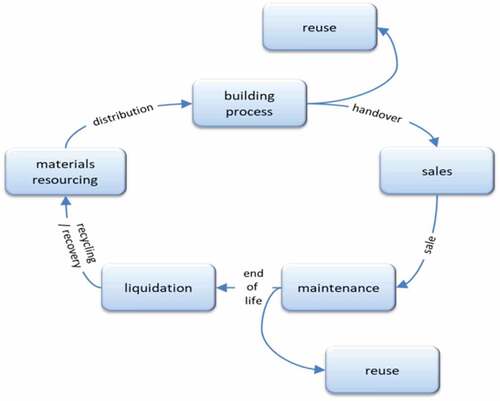 ?Mathematical formulae have been encoded as MathML and are displayed in this HTML version using MathJax in order to improve their display. Uncheck the box to turn MathJax off. This feature requires Javascript. Click on a formula to zoom.
?Mathematical formulae have been encoded as MathML and are displayed in this HTML version using MathJax in order to improve their display. Uncheck the box to turn MathJax off. This feature requires Javascript. Click on a formula to zoom.Abstract
Excessive and progressive industrialization is creating significant economic gaps, whereas large quantities of natural resources are used, and a lot of waste is created. Circular Economy (CE) aims to convert the so-called linear economy paradigm. Changes in legal regulations, business models, and construction methods are necessary for an effective CE implementation. This article aims to attract the attention of key players of the construction sector to a phenomenon of the CE. Basic conditions, a company should meet to perform an effective transformation towards the CE, were described. A hybrid, qualitative-quantitative methodology was used to research. First, a literature review is performed to describe a specificity of the construction industry and features of the construction companies in Poland. Second, a conceptual framework is developed to describe emerging CE business models. Third, a simulation-based analysis is developed to check a propensity of the construction companies to implement the CE and enhance its meaning in different types of economies. Finally, underlying a company’s condition as a factor of propensity to implement the CE, it must be noted that stable economies show higher predictability and therefore are more likely to implement principles of the CE than unstable ones. It is concluded that the European Commission should implement new rules, based on promoting closed-loop economy principles, for partnership agreements on the European structural and investment funds in the future. Especially the recommendations given in the article constitute an important contribution of the authors to the development of knowledge about CE in the construction sector.
PUBLIC INTEREST STATEMENT
The most visible proof of human’s activity on the planet is a construction industry. These noticeable signs are not just buildings and structures—final products of construction projects. It is also a huge amount of waste that is generated by construction sites around the world. Circular Economy is an idea that inspires to design and build in a way that there would be as little of this waste as possible. However, it is not that simple as it pretends to be. There are many factors of effective implementation of this new attitude. The article describes all major conditions of making this idea possible. Moreover, it includes considerations on effective methods of project execution in accordance with the Circular Economy principles.
1. Introduction
Sustainability, which has been getting more and more significant, is basically aimed at addressing environmental, and socioeconomic issues of the present and future generations (Hopwood, Mellor, & O’Brien, Citation2005; Witjes & Lozano, Citation2016). It is considered as a way to understand the world as a complex interaction between socio-economic, environmental, and political systems. Besides, it is called as an ethical or normative view of the world, convincing us to have a holistic view of what a good society should be (Sachs, Citation2015; Scheel, Citation2016).
Certainly, due to progressive resource scarcity, there is a global and increasing concern of the businesses about environmental issues. Also, a series of challenges related to the environment, are affecting not only the current development of business but also the future of the entrepreneurial activity. Generally, the exponential growth of certain key indicators is noticeable. The concentration of CO2 in the atmosphere, as well as energy, water, minerals, and natural resources demand (Reh, Citation2013), are those parameters that should worry the most. There is indisputable evidence for the environmental impact of the human activity, found in, still, huge consumption of non-renewable resources and in a generation of contaminant residues. A reduction of freshwater reserves or pollution of the atmosphere by emissions of greenhouse gases, acid rain, and destruction of the ozone layer, are all hazards that are sad signs of the unsustainable behaviour of people. Although European air quality legislation has reduced emissions of air pollutants across Europe since the 1970s (Turnock et al., Citation2016), the means are not sufficient. For example, according to OECD data a mean population exposure to particulate matter (PM 2.5), causing heavy health problems, is steady in many countries for years. Comparing 1999 and 2015 in Poland the variable was 23,64% and 23,45% whereas in Spain: 12,00% and 12,29% (OECD, Citation2018). So, the reduction of harmful pollutants since the 1970s results mainly from closing the most polluting, and at the same time the least profitable factories, especially in Central and Eastern Europe, but not from effective policies.
The most visible proof of human’s activity on the planet is the construction industry. Along with all accompanying outcomes (buildings, infrastructure etc.), it becomes one of the most significant traces of our existence on earth (Ortiz, Castells, & Sonnemann, Citation2009; Stephan & Athanassiadis, Citation2017). Unfortunately, it usually means consuming unrenewable resources, generating waste and emitting harmful gases (Esa, Halog, & Rigamonti, Citation2017). Conventional building construction manifests small recycling rate of used resources (Wadel, Avellaneda, Cuchí, & Cuchí, Citation2010). All these problems are pressing the sector to look for assessment (Ritzen, Haagen, Rovers, Vroon, & Geurts, Citation2016) and reducing the environmental impact (Lieder & Rashid, Citation2016). It seems that there is no other way than the urgent implementation of increased efficiency strategies that would help in maintaining or increasing the economic values and at the same time could reduce the environmental impact (Braungart, McDonough, & Bollinger, Citation2007).
It is expected that environmentally friendly technologies for erecting buildings, such as Contour Crafting Technology, will gain popularity in the future. The CC-technology-based automatic building is considered as a solution to bring rational benefits such as hardworking reduction, cost decrease, architectural flexibility improvement, and environmental positive effects (Khorramshahi & Mokhtari, Citation2017).
Development of the information technology (IT) should be also noted, especially building information modelling (BIM), as a virtual representation of the structure of building processes throughout the life cycle of buildings, which can be used in pro-environmental activities. The BIM model can be extended with new dimensions—nD perspectives (sustainability, energy, facility management, etc.) (Hasan & Rasheed, Citation2019).
However, the reality is more complex because there is much waste being produced during the life cycle of the construction projects (Blengini Citation2009), but on the other hand, few conceptions how to utilise it? Furthermore, limited resources force us to develop new technologies in waste recovery. They become useful when they convert outputs of the production system into some new inputs. In other words, the perfect system can be summarised by the following continuous cycle: recycling—manufacturing—use—recycling (Wadel et al., Citation2010). Therefore it is obvious that the Circular Economy (CE) can be treated as a production sustainable model, especially relevant for the construction industry. Unfortunately, very few CE-related-construction Life Cycle Assessment studies are found in the literature (Hossain & Ng, Citation2018). Fortunately, an important problem of how to measure the application of the CE principles in the construction sector is already solved (Núñez-Cacho, Górecki, Molina, & Corpas-Iglesias, Citation2017). However, there are still some issues that need to be recognised: legal regulations and social aspects, innovative technologies, new structures for construction projects, modified management frameworks of construction companies, principles of cooperation between project stakeholders etc. Therefore, governments, scientists, businessmen along with societies should develop a collaborative strategy for a sustainable world (Stigson & Stigson, Citation2015).
A practical implementation of the CE idea requires an interest of potential buyers of used or processed elements in particular phases of the building life cycle. Therefore, it is required to invite them to the communication system of the construction industry, where communication is managed by channels in all the organizations and their departments or sections. They are responsible for disseminating the related information to formulate a complete communication system (Gamil & Rahman, Citation2017).
Therefore, the research questions are:
RQ1: How should construction companies get ready for implementation of the CE?
RQ2: What is their current potential for investing in new, more ecological solutions?
RQ3: What is a propensity of the contractors to perform a transition towards the Circular Economy era?
This paper is divided into five sections including this introduction. In the second section, we present the theoretical framework, based on Industrial Ecology and concepts of Circular Economy. Next, the construction industry is featured, analysing the financial aspect of these organizations. The third part shows the degree of implementation of the Circular Economy in the Polish construction industry, and the new business models that has been generated with these new ideas about CE and sustainability- In the fourth part it is implemented a study of the propensity of building industries to implement and the fifth section presents and discusses the results, offering the conclusions drawn from the work—as well as suggestions for future research.
2. Material and methods
The research was aimed at providing a holistic overview of strategies for effective implementation of the Circular Economy in the construction sector by bringing three aspects into a multidisciplinary approach. The first question gave grounds for the elaboration of model readiness to implement the CE in a construction company. The second problem concerned the potential of the company for investing in CE-based innovations, whereas the third one included a level of the propensity of the contractors to perform a transition towards the CE.
In the initial stage, the purpose of the literature review was defined as linking the theory of industrial ecology, and sustainable construction with a concept of the Circular Economy. The selection stage depended on a literature review which was conducted using Scopus and Web of Science. Then, the National Court Register (NCR) in Poland was explored in order to extract data of 1485 random cases of construction companies which were skipped to the next phase of evaluation. Then, in order to describe features of the construction industry, the most significant Polish contractors’ webpages were analysed to find two keywords, so crucial for the paper: “sustainable development” and “Circular Economy”. Some alternatives were allowed, such as: “sustainability”, “circularity”, “economy with closed-loop” along with their Polish equivalents.
In the evaluation stage, an analysis of the data set from the NCR and five websites was conducted.
Moreover, computational analysis of the company overall condition, treated as a determinant of the successful implementation of the CE principles, was performed with use of @Risk, popular Monte Carlo simulation software.
The following block diagram (Figure ) explains the research methodology proposed in the article.
3. Theoretical framework and state of the question
3.1. Theoretical framework: linking the theory of industrial ecology and sustainable construction
Industrial ecology is the study of the flows of materials and energy through industrial systems. Focusing on the connections between operators within the industrial ecosystem, this approach aims to create closed-loop processes in which waste serves as input to another process, eliminating the notion of an unusable by-product (Clift & Allwood, Citation2011).
The theory of industrial ecology presents a synthesis of assumptions, concepts and propositions of ecology in various disciplines and the general theory of the system, being useful to describe and explain not only the interactions that occur within industries but also their transactions with the environment environmental. The perspective is based on science but applies principles, methods and results to daily activities (Bubolz and Suzanne Sontag Citation1993). For this reason, we believe that it is an optimal vision to analyse the construction industry. This theory refers to the “creation, use and management of resources for adaptation, human development and the sustainability of environments”, focusing on the interactions between the construction industry and the environment.
The theory of Industrial Ecology, current predecessor of the Circular Economy (Blériot, Citation2013) is based on three postulates: Firstly, the construction industry interacts with its environment creating an ecosystem, in which, according to the theory of systems, the parts and the whole are interdependent The interactions that occur within this ecosystem are guided by physical, biological and social laws. The industry continually requires matter and energy from the ecosystem. Second, the construction industry performs functions of physical, biological and economic maintenance, for its members, for itself and for the common interest of the entire system. In this way, this theory has a powerful value in examining these functions at different levels and their relationships among them over time. Third, there is an interdependence between the construction industry and resources. Therefore, the ecological wealth depends on the decisions and actions taken by the construction industry itself.
Therefore, the industrial ecology adopts a systemic point of view, designing production processes according to ecological constraints, while looking at their global impact from the beginning, and tries to give them shape so that they can be carried out as close as possible to the systems alive This framework is sometimes called “science of sustainability”, because of its interdisciplinary nature and because its principles can also be applied in the services sector. With an emphasis on the restoration of natural capital, industrial ecology also focuses on social well-being (Clift & Allwood, Citation2011).
Therefore, the well-being of this industry cannot be separated from the well-being of the whole ecosystem (Brown, Flavin, & Postel, Citation1989) being necessary to strike a balance between the demands of the ecosystem and those of individual industries.
In the construction industry, environmental risk is particularly evident. Many activities under processes carried out throughout the entire building life cycle have a negative impact on the environment. Therefore, there is a visible need for searching for ways to transform a traditional building process into a sustainable one (Hazem & Breesam, Citation2019).
A reduction of the environmental risk level in construction processes is conditioned by an increase of the ecological culture inspired by implementers of these processes. Such an idea can be compared to the safety culture in organizations (Tehrani, Rezaifar, Gholhaki, & Khosravi, Citation2019).
Decision making is the central process through which the construction industry directs its actions to achieve its objectives. Together, the decisions and actions of this industry have an impact on society, culture and the natural environment. This impact is called negative externality (Núñez-Cacho, Molina-Moreno, Corpas-Iglesias, & Cortés-García, Citation2018). An ecological transition occurs when a person’s position in the ecological environment is altered as a result of a change in role, on stage, or both (Bronfenbrenner, Citation1979).
3.2. Concept of circular economy
Circular Economy refers to an industrial economy that is restorative and regenerative by intent and design (Blériot, Citation2013; Lieder & Rashid, Citation2016). It is intended to rely on renewable energy, minimize the use of energy, eliminates the use of toxic chemicals and wastes eradicated through careful design. The main feature of CE is that the production system is regenerative of inputs used, diminishing the negative externalities of the process. In a generic term, it could be said that is regenerative by design. Furthermore, the main energy during production is renewable, looking for the reduction of chemical waste. The concept is supported by several key factors. Thus, to sell the use of the products and not the material, so, the consumer just use the product and the supplier is responsible to recycle the material. Customers can purchase the use as a service, and when the product becomes obsolete, recovers and renews. In such sense, reuse is a symbol of good management. The 3R principle (reduce, reuse and recycling) contributes to reducing the press over the global resources stock (Reh, Citation2013). According to Walter Stahel (Stahel, Citation2013) in the past, reuse was a strategy shortage and poverty. Today, they are signs of efficient management of resources.
There are several factors determining the success of the Circular Economy. Modularity, versatility and adaptability are the most important properties of products or systems enabling them to be a part of the production chain (Seebacher & Winkler, Citation2013; Wiendahl et al., Citation2007). Production systems, owing to new technologies developed through the transfer of function from biological systems (Lepora, Verschure, & Prescott, Citation2013), can become more sustainable. One of the major challenges of biomimetics (Gebeshuber, Gruber, & Drack, Citation2009) includes translating the natural life cycle into a technological situation. The theory “cradle to cradle” is an important theme of Circular Economy, as it tries to imitate nature imitating the biological recycling process, but with industrial materials (Blériot, Citation2013). However, it is necessary to analyze both, processes and products that can be bio-mimicked.
3.3. Featuring construction enterprises: financial profile
Use of new material solutions (product innovations) often requires changes at a process level (process innovations). Adaptation of enterprises to new, previously unused, rules of conduct in business, among others in the field of resource management, including material and energy flow, as well as waste recovery, requires finding new organizational methods (organizational innovation). However, these types of innovation can be treated as “traditional” or green innovations. The latter, on the other hand, can be defined as the products and processes that contribute to a reduction of environmental impact or to achieve ecologically specified sustainability targets (Arfi, Hikkerova, & Sahut, Citation2018). Such changes lead to the birth of innovative business models, also known as circular business models which require inter-organizational sustainability management (Korhonen, Honkasalo, and Jyri Citation2018). On the other hand, an implementation of the CE in companies, treated as a systemic innovation, is conditioned by financial results (Kirchherr et al., Citation2018). Financial constraints in general increase the probability of abandoning an innovation project (García-Quevedo, Segarra-Blasco, & Teruel, Citation2018). Moreover, financial distress often leads to bankruptcy of a company. Therefore to determine a propensity of the industry to implement CE, a financial aspect of the construction industry has to be featured. This research analyses the main financial factors in construction companies and, on this basis, finding appropriate means towards drastic improvement in the functioning of the enterprise. Firstly, a literature review was conducted, linking sustainability and construction industry. It helped to analyse features of the sector. After that, a database of the construction enterprises taken from the National Court Register in Poland was explored. As a result 1485 random selected cases of construction companies were skipped to next phase of evaluation. Parameters of the sample are presented in Table .
Table 1. Features of sample
On the basis of the data, the main profitability indicators were calculated. Results of medians of the return on sales (ROS), return on assets (ROA) and return on equity (ROE) observed in 1485 random cases of Polish construction companies (2014–2016) sorted by trades are presented in Figure . The most profitable branch regarding the return on equity indicator is railway construction. It can be conditioned by limited competition between contractors coming from higher start-up costs (e.g. machinery). Also, a relatively low number of the cases in the sample (33) may influence the lower credibility of such calculation. According to some theoretical considerations, it has to be underlined that in properly functioning companies the following inequity is observed: ROE>ROA>ROS. In this study, 69% of cases fulfils this assumption. Moreover, generally the higher ROE the better, but it should be higher than an inflation rate (Zaleska, Citation2005) to omit the negative consequences of the loss of value. In the research, only 219 out of 1485 cases were prone to such danger. In order to answer the leading question: how should construction companies get ready for implementation of the CE?—it can be noted that management staff should strive to gain the highest possible ROE and to meet other expectations connected with profitability indicators, especially the inequity mentioned above.
Figure 2. Probability indicators: medians of ROS, ROA, ROE observed in 1485 random cases of polish construction companies (2014–2016) by trades

Further considerations were focused on measuring asset turnover ratios (ATR) among the chosen cases of Polish construction companies. Figure presents the median values of the indicators sorted by trades.
Figure 3. Medians of asset turnover ratio in 1485 random polish construction companies (2014–2016) by trades
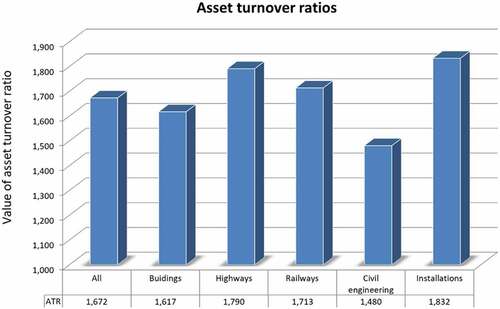
The highest median of ATRs is observed among companies responsible for installations whereas the lowest in case of contractors connected with other civil engineering structures.
Although in literature, there are known more complex analysis to predict the performance of companies and their chances of business survival (Chen, Citation2012; Chen, Mu-chun, and Badjie Citation2016; Kangari, Farid, & Elgharib, Citation1992), in business, sometimes it is crucial to find simple answers to complex questions. Quantitative model based on the three financial ratios (ROE>ROA>ROS) to assess the financial performance gives such opportunity.
4. Implementation of circular economy in the construction sector and new business models
4.1. Position of the construction industry facing circular economy
The new challenges that the construction industry faces in the twenty-first century can be considered as a chance to gain a competitive advantage by the companies. However, they need to find efficient means for economic success, especially changes in the way they manage their business (e.g. corporate social responsibility), in methods of construction and in the organization of projects. If these changes are new and create value-added for a company, they can be called innovations (Girmscheid & Hartmann, Citation2001). The construction industry is quite unique. It evokes a necessity for paying attention to various attributes and different constraints, e.g. environment regulation (Zhang, Hui, Xia, & Skitmore, Citation2018), corporate social responsibility (Xia, Olanipekun, Chen, Xie, & Liu, Citation2018), etc.
In order to describe features of the construction industry, it was decided to verify what kind of terminology connected with sustainability is used by the most significant players on the market. Poland was chosen as an experimental field. The country has been a member of the European Union since 2004. Moreover, Polish construction companies will focus on taking advantage of the increased project volume in the upcoming years and at the same time, they will focus on ensuring growth and value in the long term (Sarwarzadeh, Sinke, Sturm, & Zegger, Citation2017). To perform the experiment, main websites of largest construction companies in Poland by revenue in 2016 (Deloitte Polska, Citation2017) were analysed to find two keywords, so crucial for the paper: “sustainable development” and “Circular Economy”. Some alternatives were allowed, such as: “sustainability”, “circularity”, “economy with closed-loop” and their Polish equivalents. At first, the main webpage was analysed. A researcher’s purpose was to find proper keywords during the first 10 seconds of a visit on the website. If an attempt was successful, and a keyword was found, a test was marked as positive. Otherwise, it received a negative label. Then the same procedure was performed but this time with the use of a built-in search engine on the webpage. The results of the trial are presented in Table .
Table 2. Results of finding keywords: “sustainable development” and “circular economy” on websites of top 5 polish companies and their in-built search engines, 2017
As it seems, the results are quite gloomy. Although managers hired in construction companies from time to time confirm that ecology issues are important and environmental protection (as a part of the corporate social responsibility) is treated as a priority (Górecki, Citation2016), the facts differ from reality. Only three out of five top, according to (Deloitte Polska, Citation2017), contractors in Poland present information about sustainability online—on their corporate websites. None publish their involvement in looping production cycles and use the “Circular Economy” keyword. There is only a little information about recycling, waste segregation etc. It is quite interesting that their counterparts or parent companies present such content on the website (Ferrovial or Skanska Group). Obviously, the body of websites is mainly used for marketing or public relations purposes (Gustavsen, Citation2003) but it gives an overview of the organizational culture (Yanney, Citation2014).
4.2. Innovative strategy for limiting environmental impact?
The inputs of the construction system consist of the huge amounts of resources needed to carry out the construction. Project management is required in order to maintain the process of assembly of the building when the resources are used. Finally, an output of the system means finished building (Fewings, Citation2005). The same applies to the construction of roads, infrastructure and other structures.
Waste, in turn, is considered as a negative externality of the construction system. It is desired to minimise this impact (Esa et al., Citation2017; Ilić & Nikolić, Citation2016; Wilson, Velis, & Cheeseman, Citation2006), however, the environmental impact and the resource value of the waste are main drivers for the development of waste management. Despite the fact that business activity is not primarily aimed at solving global environmental problems, managers try to perceive environmental issues as an integral part of a business strategy. Such an attitude may enable them to develop a positive image and, what more important, gain a competitive advantage. For manufacturers of construction materials, identification of the waste flows that can be generated or used throughout the life cycle of such products is very important (Silvestre, De Brito, & Pinheiro, Citation2014). However, considering a broader sense of business activity, it is necessary to mention undertakings of a construction nature—construction investment projects. Their stakeholders start to focus on better waste management policies and standards implementation. From point of view of investors, a typical life cycle of a sustainable construction project consists of five project phases: sustainable design process, sustainable production of sustainable materials and equipment, sustainable building process, sustainable maintenance, and sustainable liquidation, meaning the conversion of outputs into the inputs as reuse, remanufacturing or recycling (Núñez-Cacho et al., Citation2017). In the further part of the article, this idea will be used to create principles for the closed-loop project value chain management of the construction projects. On the other hand, the contractors want to diminish their contribution to natural resource degradation too. There is no doubt that there is a purpose in this. For some, it is a way how they can manifest the solicitude for the future generations. Others want to use it as a competitive advantage or simply as a slogan. However, in both cases, it is about minimising the risk of the business in the short and long term.
The growing importance of reverse logistics (Chinda, Citation2017; Jiang & Zhang, Citation2016; Rahimi & Ghezavati, Citation2018; Trochu, Chaabane, & Ouhimmou, Citation2018), treated as material flows from customer to manufacturer, appears as a significant challenge for management. Nowadays managers must take into account not only flow to a customer, but also in the opposite direction. Such strategy opens a possibility to receive a new product of standard, but recovered value. New inputs coming from the recovered materials allow to close the cycle and obtain a closed loop in the supply chain (Jimenez-Rivero & Garcia-Navarro, Citation2017). On the other hand, for making this purpose possible, it is necessary to favour selected construction solutions (e.g. disassemblable parts, bolted joints etc.) in the design of structures so that the end-of-life construction materials could be easily obtained (Bribián, Capilla, & Usón, Citation2011). However, the closed-loop supply chain in enterprises reconciles two main virtual contradictions: business development and environmental protection.
Integration of the Circular Economy (CE) principles within sustainable supply chain management provides many advantages for the environment in comparison to a traditional linear model (Nasir, Genovese, Acquaye, Koh, & Yamoah, Citation2017). The CE is a generic term for an industrial economy that uses design to restore its inputs. The CE aims to simulate nature, which in its biological cycle does not discard any matter at any time but which, at the end of the use, finds productive inputs to another process. Such simulation, being a part of the second principle of Natural Capitalism (Hunter and Cohen Citation2011), occurs very useful in the construction sector. In this way, the construction process is conducted in a cheaper and cost-effective way. Therefore, the rules are not brand new. Mother Nature has known them for thousands of years. However, their application in industries is innovative.
It is believed that the new philosophy of production results in the indefinite reuse of the factors of production and their derivatives that are used in the process. The main objective is to rethink the model of the traditional, linear economy, in which the sector cannot find optimal solutions in terms of sustainability and the environment. The use of new resources derived from recoverable waste produced by manufacturers can benefit both economically and environmentally.
However, the implementation of the CE has to be preceded by the following changes. Firstly, the sector must be theoretically prepared for more efficient business models including knowledge about more sustainable production systems. Moreover, the industry has to be equipped with new technologies, facilities, management models and digital platforms to be able to profit from the change. Then, the market has to be educated about the financial and ecological advantages of the CE. However, it is not only the construction project itself that needs to evolve. The way a building, road or infrastructure are maintained requires similar evolution as a part of new business models. Secondly, the industry must generate and promote reliable measures of the company’s condition being a factor of its propensity to implement the CE. One of such methods is proposed in the further part of the article. Thirdly, the construction sector should promote policies providing the long-term, reliable financial support for construction projects executed in compliance with the CE principles. Providing high quality technological “nutrients” (Galan-Arboledas, Cotes-Palomino, Bueno, & Martinez-Garcia, Citation2017; Martin-Morales, Cuenca-Moyano, Valverde-Espinosa, & Valverde-Palacios, Citation2017) can be prone to high economic risk (Machacek, Richter, & Lane, Citation2017; Masi, Day, & Godsell, Citation2017). It is proposed to convince the European Commission to implement new rules, based on promoting closed-loop economy principles, for partnership agreements on the European structural and investment funds after 2020. Thanks to such law the funds could appear as a solution for minimising the risk of the construction investment projects. Lastly, a new concept of the certification system should be developed. It could be useful for the previous issue to measure the CE and give assurance certificates in different areas and on particular levels (sector, industry, market, project, organisation etc.). Eurostat monitoring framework tool can be helpful to measure total implementation of the Circular Economy in a country or in the European Union. However, a proposal for measuring the CE especially intended for the construction sector has been described so far in the literature (Núñez-Cacho et al., Citation2017).
4.3. Emerging circular economy business models and SCM of the construction industry
The new European legislation, widely known as the Circular Economy Action Plan, implies a “radical” change in managerial conceptions, orienting itself towards the paradigm of the Circular Economy and promoting reuse. For example, the EU Strategy for Plastics in the Circular Economy establishes that by 2030, all plastics packaging should be recyclable (European Commission, Citation2017). Moreover, 70 % recovery target for construction and demolition waste was set for 2020, however, according to recent reports (European Commission, Citation2018), it should be underlined that the percentage includes backfilling of non-hazardous construction and demolition waste excluding naturally occurring material. Unfortunately, it is a practice which does not keep the value of the materials in the economy and is therefore not conducive to the Circular Economy.
Supply chain management was adopted into the construction industry in order to make it more effective and more efficient. So far, the complexity of construction supply chain management has been explained in the literature (Behera, Mohanty, & Prakash, Citation2015). However, a business model is a comprehensive understanding of how a company does business (Beattie & Smith, Citation2013; Witjes & Lozano, Citation2016) and creates value (Afuah, Citation2004). It has to be noted that developing circular structures requires a new process design where a variety of disciplines in the supply chain is integrated. Moreover, according to (Leising, Quist, & Bocken, Citation2018), an extension of responsibilities to actors along the entire building supply chain, and new business and ownership models are necessary as well.
In the following Figures –, a semi-closed loop supply chain concept for construction projects is presented. Also, a range of occurrence of the finished outcome, e.g. building (green triangle) is marked. Basically, supply chains (Khalfan, Khan, & Maqsood, Citation2015; Nasir et al., Citation2017) are mapping the mutual relationship between construction project stakeholders in the flow of materials. Its structure corresponds to the project. Semi-closed loop supply chains are established to specify reverse logistics and underline a whole life cycle of the project. Three different business models (general contractor, real estate development and integrated supply chain typical for project management) are proposed as a road map towards full integration within the supply chain. This concept promotes project management model as a target for the investors whose expectations are connected with the CE implementation.
Figure 4. Semi-closed loop supply chain for the construction projects and area of occurrence of the finished outcome, e.g. building (green triangle)
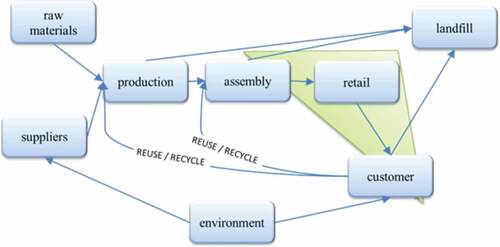
Figure 5. Semi-closed loop supply chain for the conventional model of construction projects and area of occurrence of the collaboration between participants (red circle)
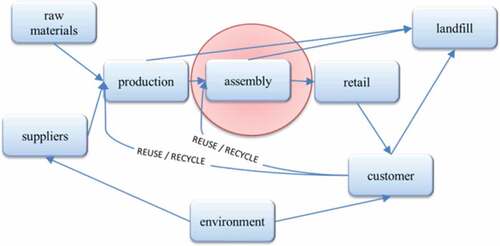
Figure 6. Semi-closed loop supply chain for the real estate development model of construction projects and area of occurrence of the collaboration between participants (red circle)
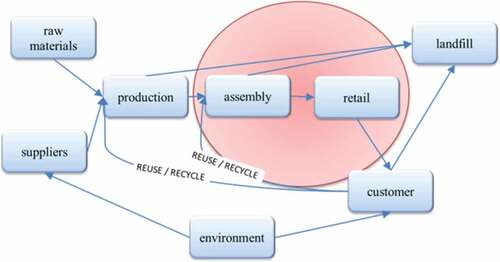
Figure 7. Semi-closed loop integrated supply chain for the construction projects and area of occurrence of the collaboration between participants (red circle)
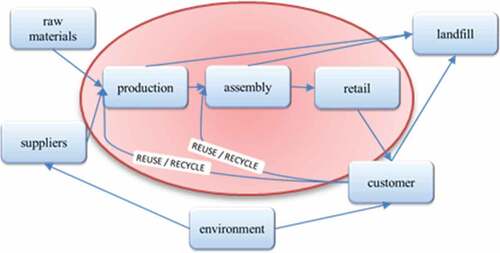
As a matter of fact, all previous models do not fully meet assumptions of the Circular Economy. Therefore, Figure presents a closed-loop supply chain for construction projects. On the other hand, Figure shows a model for closed-loop project value chain management (Kelly, Male, & Graham, Citation2014) of the construction projects.
Alike in a company (traditional value management), construction projects also require a structured management methodology for improving decision-making and value-for-money. In the company, value chain management is intended to deliver a valuable product for the customer, whereas in the construction project, the valuable product must be delivered to the project’s owner. The last model refers to meeting the client’s requirements regarding the exclusion of waste and improving the efficiency of resources used during the construction project.
Companies in the construction sector face a high level of risk which usually originates from decision-making processes of different nature. An implementation of the strategy of risk management is one of the forms of restructuring the management of the organization (Górecki and Jadwiga Citation2018). A fundamental matter of the risk management is to recognise the factors, which are crucial for the construction project management—objective perspective—as well as for a project stakeholders’ point of view—subjective perspective (Górecki & Bizon-Górecka, Citation2017). In order to answer the research question: what is the current potential of construction companies for investing in new, more ecological solutions?—holistic research on their financial profile and the specificity of the construction industry had to be done. There is no doubt that large contractors are ready to meet new challenges and to start implementing CE principles in their projects, however, the risk can slow down the pace or limit this transition. However, the construction sector includes not only financially stronger large companies but primarily numerous small and medium construction enterprises. In this context, a comprehensive, multidimensional analysis of propensity to implement Circular Economy in a particular construction company is needed. Such an attitude requires taking into consideration both microeconomic, and macroeconomic factors.
5. Simulations of propensity to implement circular economy
5.1. Company condition model
According to Bogle, the most significant problem with capitalism today is a tremendous focus on the short-term (Bogle, Citation2010). However, building corporate value over the long-term is quite and unfortunately, there are no quick or easy shortcuts. This contestation may explain the low propensity of companies to invest in truly environment-friendly solutions and why they choose the easy but not effective shortcuts (e.g. backfilling).
A reliable promise of gaining competitive advantage can convince construction companies of their inevitable need for a transition to the Circular Economy. Therefore in order to make this idea happen, appropriate incentives should be created to develop this new market. The construction sector and its players must generate and promote reliable measures of a company’s condition which could be treated as a factor of its readiness to implement the CE. It is proposed to estimate the overall status of the company on the basis of the Equationequation (1)(1)
(1) .
where:
R—company’s revenue, GC—company’s gross cost (gross cost = revenue—net profit), ΔVA—annual change in gross value added at factor cost related to Circular Economy sectors in a country (Eurostat, Citation2014), Δi—annual change in inflation rate in a country, ΔLP—annual change in labour productivity in a country, ΔMW—annual change in minimum wages in a country.
The first fraction is related to a financial condition of the analysed company (should be more than 1, the more the better). The second one describes a dynamic of the circularity in a country where the company operates. The last fraction presents a dynamic of labour efficiency in the country. A result of the multiplication gives an answer about the company’s status based on micro- and macro-environmental measures. Indicators related to the entity are available from its financial documents whereas those connected with the sector and cross-sector features can be obtained from the Eurostat.
5.2. Monte carlo simulations and results
For a purpose of this article, a conceptual framework for simulations was used to prepare an example of calculation of company’s propensity to implement the Circular Economy in two types of economies: stable—playing pioneering role in sustainability efforts and renewable energy, like Denmark or Sweden (Andreas, Burns, & Touza, Citation2017))—and, by contrast, unstable. For the first alternative, target values and distribution parameters of their reliability were established on the basis of the expert method. Economies described by their stability or instability, which have been widely explained in the literature (Nasir, Ahmad, Ahmad, & Junjie, Citation2015; Wu, Citation2018), can be represented by different risk distribution of value predictions. In the example, stability is featured by normal distributions whereas instability by triangular. Computational analysis was performed with the use of the Monte Carlo (MC) simulation method. Details of the simulation are presented in Table .
Table 3. Details of computational analysis performed in @Risk (Palisade)
Use of the MC was justified earlier (Núñez-Cacho et al., Citation2017). In Figure , the results of two simulations (one for stable—red—and one for unstable—blue—economy case) are shown. It can be noted that a level of prediction risk implies the shape of a probability distribution.
Figure 10. Probability density of the company’s condition as a factor of propensity to implement circular economy in two types of economies: stable (red) and unstable (blue)
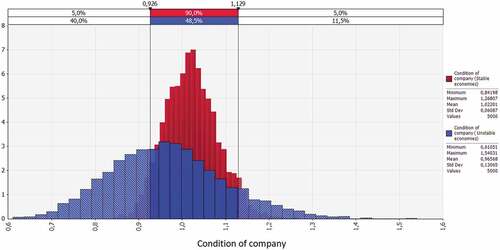
It also reveals that there might be different patterns of propensity to implement the CE in particular companies or countries. Moreover, smart legislation concerning this matter in the European Union should take these discrepancies into account. Figures and 1 explain that the final result may be conditioned by different factors but not to the same extent.
Figure 11. Tornado chart—simulation sensitivities of company’s condition as a factor of propensity to implement circular economy in stable economies
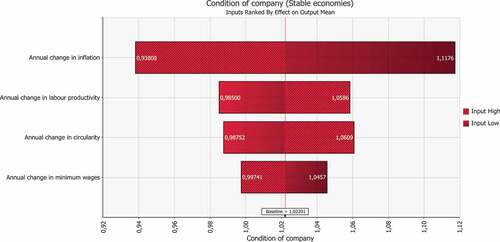
It can be noted that an annual change in inflation impacts the most the condition of the company in stable economies. Among other factors of propensity to implement Circular Economy, there is an annual change in labour productivity, an annual change in circularity, and an annual change in minimum wages, however, these variables have less influence on the company’s condition.
Figure 12. Tornado chart—simulation sensitivities of company’s condition as a factor of propensity to implement circular economy in unstable economies
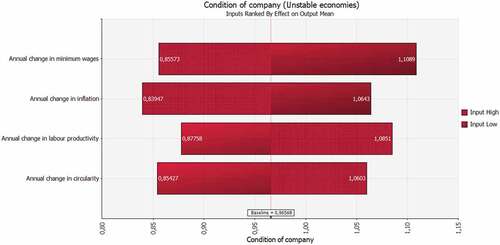
For unstable economies, the results are not so clear. In fact, all four variables have a similar effect on the company’s condition treated as a factor of propensity to implement Circular Economy.
The undeniable advantage of this type of approach is the ability to perform analyzes in a dynamic way, i.e. taking into account changing conditions (economic, sustainable etc.).
There is no doubt that the Circular Economy has the potential to contribute to the creation of jobs and economic growth but smart support can make it real. Innovation and investments—on ecological technologies, on secondary raw materials, on recycling processes and on industrial symbiosis—are key factors of the transition to the Circular Economy. Therefore, there must be favourable conditions for the development of such activities. The last research question: what is a propensity of the contractors to perform a transition towards the Circular Economy era?—recalls that the condition of the company depending on microeconomic and macroeconomic circumstances determines its willingness to risk in such innovations. An enterprise, ready for new challenges, is one whose financial position is stable. However, without the presence of other incentives, the success of such ventures may be prone to risk.
6. Discussion
The Circular Economy can contribute to creating new posts and economic growth. Investments on eco-innovations (eco-design, secondary raw materials, recycling processes, industrial symbiosis) are a key factor of the transition to closed-loop production systems. There is no doubt that such strategy can be profitable and should be treated in the construction industry very seriously, however, a curious thing is what is a propensity of the contractors and other market players to perform a transition towards an era of the CE.
After previous articles and the findings of measuring closed-loop-production thinking in the construction companies, this time, the paper’s main contribution is to describe how should construction companies get ready for implementation of the CE and what is their current potential for investing in new, more ecological solutions. It is underlined that the main condition of the company’s transition to the Circular Economy is its financial stability and potential calculated by the proposed model. It is worth to consider if it would be better to put reliable data based on the historic numbers rather than distribution parameters given by experts. To make it real, it is required to create a consistent and open-access database containing information crucial for the algorithm.
The analysis also reveals the ideas of how international bodies like the European Union should create efficient policies to encourage companies to discover new remedies for resource scarcity and business risk. Moreover, it is proposed to convince the European Commission to implement new rules, based on promoting closed-loop economy principles, when new partnership agreement frameworks on the European structural and investment funds will be prepared. In such a case, the funds could appear as a solution for minimising the risk of the construction investment projects executed in compliance with the principles of the CE.
An implementation of the Circular Economy in the construction sector requires macro- but also micro-economic attitude. As a result of the study, different business models (general contractor, real estate development and integrated supply chain typical for project management) are proposed as a road map towards full integration within supply chain treated as a method for managing material and waste flow in sustainable construction projects. On the other hand, the value chain is considered as a powerful tool to manage a process of value-adding in the construction project, especially if it is conducted in harmony with the CE. These findings are a novelty because concern adopting the value chain management into sustainable construction projects.
Based on the analysis and findings from the research, the article identifies strategies for effective implementation of the Circular Economy in construction sector, determines that financial incentives can help to boost CE-based innovations, and to convince construction market to risk for investments connected with closed-loop project value chain management in construction projects but on the other hand it discloses several research gaps for further studies:
How should construction companies manage the risk of CE implementation?
How do theoretical models of financial performance refer to reality?
7. Conclusions
Currently, an increasing number of market players realise that limited resources are not only a matter of finite money they manage but also (and perhaps) primarily a matter of the resource scarcity. Moreover, many urban areas worldwide have been developed rapidly. This has caused serious environmental problems, including pollution, floods, smog, etc. These occurrences evoked a need for immediate changes. Today, the concept of the ecological perspective has become increasingly popular and for many, sustainable development as well as the Circular Economy concept—primarily in the construction sector—has become the only way to avoid this problem in the future.
The practical implementation of the CE can be performed in two steps. First, vertical including companies, industrial parks, communities, countries, international bodies. Second, horizontal involving industries and sectors. Therefore, the CE should be implemented at the macro-economic level (legal regulations, policies, requirements, certificates etc.), then companies will notice that it is worth investing in such solutions and there are some safeguards against the business risk. The most significant incentive may be financial support of the European Union for only those infrastructure projects in which the idea of the Circular Economy is fully implemented.
The consequences of this research can bring a revolution in the distribution of the structural and investment funds if the above idea is accepted by European authorities and all members of the European Union. Circular Economy may become an economic flywheel in many countries. The money allocated for investments in modern, environmentally friendly technologies will help to achieve not only a higher level of economic development but also a relief for nature. The transition to the era of the Circular Economy in construction sector means not only new, previously unused materials or cleaner technological processes, but also healthy societies or new jobs in the construction market.
8. Limitations and further research
Selected 1485 cases of construction companies from the National Court Register database in Poland were analyzed by different specialities: building, highway, railways, civil and installation. Most large construction companies have different divisions, which may cover some or all the above mentioned specialities. Therefore, the analysis by different trade may not be able to directly indicate how the ROS, ROA, ROE are related to the company profitability for large companies. However, the comparison shown in the article is indicative, and the division used does not apply to pure specialities, but only to leading ones.
In the analysis of some companies’ websites, searched keywords were: “sustainable development” and “Circular Economy”. Indeed, the searching method cannot strongly correlate the construction companies with sustainable development or Circular Economy until the search results were further verified and processed. It is possible that some misunderstandings or inappropriate descriptions were found on the websites. Without a doubt, it would be better to go extra steps to verify if the construction companies were implementing sustainable construction technologies or altering the traditional construction materials to reusable materials and thus they know what sustainability or CE is. However, this article was focused on the simple presence of certain triggers on the home page of companies, which is often their showcase. It was assumed that if something is not mentioned on the website, it is less important, at least from the point of view of customer relations. Future research will be focused on deepening the essence of the problem.
Acknowledgements
This work was supported by the Statutory research for scientists at the UTP University of Science and Technology, Faculty of Civil and Environmental Engineering, and Architecture under Grant No. BSM-61/2018.
Additional information
Funding
Notes on contributors
Jarosław Górecki
Jarosław Górecki assistant professor of Civil Engineering at UTP University of Science and Technology, Ph.D. (Eng.) (2014); MSc (civil engineering) 2008, BSc (management) 2007. Research interests cover: construction management, especially decision-making problems, and risk management as well as project management maturity, and Circular Economy.
Pedro Núñez-Cacho
Pedro Nunez-Cacho assistant professor of Business Organization at University of Jaén, Ph.D. (2014); MSc (management) 1995. Research interests cover: sustainability, innovation in family businesses as well as innovation and Circular Economy.
Francisco Antonio Corpas-Iglesias
Francisco Antonio Corpas-Iglesias professor of Materials Science and Metallurgical Engineering at University of Jaén, Ph.D. (1999). Research interests cover: engineering of materials, development of materials for a sustainable construction and the valorization of waste as well as Circular Economy.
Valentín Molina
Valentín Molina associate professor of Management at University of Granada, Ph.D. (2006). Research interests cover: sustainability, green economy, social economy, Circular Economy, inverse logistics, social entrepreneurship, project and process management, and development of territories.
References
- Afuah, A. (2004). Business models: A strategic management approach. New York, NY: McGraw-Hill/Irwin.
- Andreas, J.-J., Burns, C., & Touza, J. (2017). Renewable energy as a luxury? A qualitative comparative analysis of the role of the economy in the EU’s renewable energy transitions during the ‘double crisis.’. Ecological Economics, 142, 81–22. doi:10.1016/j.ecolecon.2017.06.011
- Arfi, W. B., Hikkerova, L., & Sahut, J.-M. (2018). External knowledge sources, green innovation and performance. Technological Forecasting and Social Change, 129, 210–220. doi:10.1016/j.techfore.2017.09.017
- Beattie, V., & Smith, S. J. (2013). Value creation and business models: refocusing the intellectual capital debate. The British Accounting Review, 45(4), 243–254. doi:10.1016/j.bar.2013.06.001
- Behera, P., Mohanty, R. P., & Prakash, A. (2015). Understanding construction supply chain management. Production Planning & Control, 26(16), 1332–1350. doi:10.1080/09537287.2015.1045953
- Blengini, G. A. (2009). Life cycle of buildings, demolition and recycling potential: A case study in Turin, Italy. Building and Environment, 44(2), 319–330. doi:10.1016/j.buildenv.2008.03.007
- Blériot, J. (2013). Cradle to cradle - products, but also systems. Retrieved from http://www.ellenmacarthurfoundation.org/news/cradle-to-cradle-products-but-also-systems
- Bogle, J. C. (2010). Don’t count on it!: Reflections on investment illusions, capitalism, “mutual” funds, indexing, entrepreneurship, idealism, and heroes. Hoboken, New Jersey: John Wiley & Sons, Inc.
- Braungart, M., McDonough, W., & Bollinger, A. (2007). Cradle-to-cradle design: Creating healthy emissions - a strategy for eco-effective product and system design. Journal of Cleaner Production, 15(13–14), 1337–1348. doi:10.1016/j.jclepro.2006.08.003
- Bribián, I. Z., Capilla, A. V., & Usón, A. A. (2011). Life cycle assessment of building materials: Comparative analysis of energy and environmental impacts and evaluation of the eco-efficiency improvement potential. Building and Environment, 46(5), 1133–1140. doi:10.1016/j.buildenv.2010.12.002
- Bronfenbrenner, U. (1979). The ecology of human development: Experiments by design and nature. Massachusetts, USA: Harvard University Press.
- Brown, L. R., Flavin, C., & Postel, S. 1989. A world at risk. State of the World: A Worldwatch Institute Report on Progress toward a Sustainable Society (pp. 3–20). New York: Norton.
- Bubolz, M. M., & Suzanne Sontag, M. (1993). Human ecology theory. In P. G. Boss, W. J. Doherty, R. LaRossa, W. R. Schumm, & S. K. Steinmetz (Eds.), Sourcebook of family theories and methods: A contextual approach (pp. 419–450). New York: Plenum Press. doi:10.1007/978-0-387-85764-0_17
- Chen, J. H. (2012). Developing SFNN models to predict financial distress of construction companies. Expert Systems with Applications, 39(1), 823–827. doi:10.1016/j.eswa.2011.07.080
- Chen, J. H., Mu-Chun, S., & Badjie, B. A. (2016). Exploring and weighting features for financially distressed construction companies using swarm inspired projection algorithm. Advanced Engineering Informatics, 30(3), 376–389. doi:10.1016/j.aei.2016.05.003
- Chinda, T. (2017). Examination of factors influencing the successful implementation of reverse logistics in the construction industry: Pilot study. In K. Halicka & L. Nazarko (Eds.), Procedia engineering (Vol. 182, pp. 99–105). SARA BURGERHARTSTRAAT 25, PO BOX 211, 1000 AE AMSTERDAM, NETHERLANDS: ELSEVIER SCIENCE BV. 7TH INTERNATIONAL CONFERENCE ON ENGINEERING, PROJECT, AND PRODUCTION MANAGEMENT. doi:10.1016/j.proeng.2017.03.128
- Clift, R., & Allwood, J. (2011). Rethinking the economy. Chemical Engineer, 837(March), 30–31. Retrieved from http://epubs.surrey.ac.uk/834330/
- Deloitte Polska. (2017). Polish construction companies 2017. Major players, key growth drivers and development prospects. Retrieved from https://www2.deloitte.com/content/dam/Deloitte/pl/Documents/Reports/pl_en_polish_construction_companies_2017.pdf
- Esa, M. R., Halog, A., & Rigamonti, L. (2017). Developing strategies for managing construction and demolition wastes in Malaysia based on the concept of circular economy. Journal of Material Cycles and Waste Management, 19(3), Springer Japan, 1144–1154. doi:10.1007/s10163-016-0516-x
- European Commission. 2017. Communication from the commission to the European Parliament, the council, the European economic and social committee and the committee of the regions. Commission work programme 2018. An agenda for a more united, stronger and more democratic Europe.
- European Commission. 2018. Communication from the commission to the European parliament, the council, the European economic and social committee and the committee of the regions on a Monitoring Framework for the Circular Economy.
- Eurostat. (2014). Structural business statistics (SBS). Retrieved from http://ec.europa.eu/eurostat/web/circular-economy/indicators/monitoring-framework
- Fewings, P. (2005). Construction project management: An integrated approach. New York: Taylor & Francis. Retrieved from https://civiltrack.files.wordpress.com/2017/03/construction-project-management-an-integrated-approach-by-peter-fewings.pdf
- Galan-Arboledas, R. J., Cotes-Palomino, M. T., Bueno, S., & Martinez-Garcia, C. 2017. Evaluation of spent diatomite incorporation in clay based materials for lightweight bricks processing. Construction and building materials (Vol. 144, pp. 327–337). The Boulevard, Langford lane, Kidlington, Oxford OX5 1GB, Oxon, England: Elsevier Sci Ltd. doi:10.1016/j.conbuildmat.2017.03.202.
- Gamil, Y., & Rahman, I. A. (2017). Identification of causes and effects of poor communication in construction industry: A theoretical review. Emerging Science Journal, 1(4). doi:10.28991/ijse-01121
- García-Quevedo, J., Segarra-Blasco, A., & Teruel, M. (2018). Financial constraints and the failure of innovation projects. Technological Forecasting and Social Change, 127, 127–140. doi:10.1016/j.techfore.2017.05.029
- Gebeshuber, I. C., Gruber, P., & Drack, M. (2009). A gaze into the crystal ball: Biomimetics in the year 2059. Proceedings of the Institution of Mechanical Engineers, Part C: Journal of Mechanical Engineering Science, 223(12), 2899–2918. doi:10.1243/09544062JMES1563
- Girmscheid, G., & Hartmann, A. (2001). Innovation management in construction companies an integrated model. CIB World Building Congress (pp. 1–10). Wellington. doi:10.3929/ethz-a-006000593
- Górecki, J. (2016). Innovation implementation readiness among construction companies. Materiały Budowlane, 526(June), 170–171. doi:10.15199/33.2016.06.74
- Górecki, J., & Bizon-Górecka, J. (2017). Risk management in construction project: Taking fairness into account. World multidisciplinary civil engineering-architecture-urban planning symposium - Wmcaus. Vol. 245. IOP Conference Series-Materials Science and Engineering, Prague, Czech Republic doi:10.1088/1757-899X/245/7/072024
- Górecki, J., & Jadwiga, B. G. (2018). Risk manager as a creator of the company’s project maturity. In K. S. Soliman (Eds.), Proceedings of the 31st International Business Information Management Association Conference, IBIMA 2018: Innovation Management and Education Excellence through Vision 2020 (pp. 1579–1587), Milan, Italy. doi:10.5650/jos.ess18140
- Gustavsen, P. A. (2003). Public relations communication through corporate websites: Towards an understanding of the role of interactivity. PRism, 1(1). Retrieved from http://praxis.massey.ac.nz/fileadmin/Praxis/Files/Journal_Files/issue1/refereed_articles_paper5.pdf
- Hasan, A. N., & Rasheed, S. M. (2019). The benefits of and challenges to implement 5D BIM in construction industry. Civil Engineering Journal, 5(2), 412. doi:10.28991/cej-2019-03091255
- Hazem, R. T., & Breesam, H. K. (2019). Development of possible solution to overcome factors influence on sustainable construction process. Civil Engineering Journal, 5(7), 1506–1517. doi:10.28991/cej-2019-03091348
- Hopwood, B., Mellor, M., & O’Brien, G. (2005). Sustainable development: Mapping different approaches. Sustainable Development, 13(1), 38–52. doi:10.1002/sd.244
- Hossain, M. U., & Ng, S. T. (2018). Critical consideration of buildings’ environmental impact assessment towards adoption of circular economy: An analytical review. Journal of Cleaner Production, 205(December), Elsevier, 763–780. doi:10.1016/J.JCLEPRO.2018.09.120
- Hunter, L. L., & Cohen, B. (2011). Climate capitalism. Capitalism in the age of climate change. New York: Hill and Wang. Retrieved from https://ncse.com/files/pub/evolution/excerpt–capitalism2.pdf
- Ilić, M., & Nikolić, M. (2016). Drivers for development of circular economy – a case study of Serbia. Habitat International, 56(August), Pergamon, 191–200. doi:10.1016/J.HABITATINT.2016.06.003
- Jiang, N., & Zhang, J. (2016). Construction and optimization of recycling logistics network for construction waste. In J. Yu & Q. Liu (Eds.), ACSR-advances in comptuer science research (Vol. 50, pp. 726–730). 29 AVENUE LAVMIERE, PARIS, 75019, FRANCE: ATLANTIS PRESS. PROCEEDINGS OF THE 2016 4TH INTERNATIONAL CONFERENCE ON ELECTRICAL & ELECTRONICS ENGINEERING AND COMPUTER SCIENCE (ICEEECS 2016).
- Jimenez-Rivero, A., & Garcia-Navarro, J. (2017). Best practices for the management of end-of-life gypsum in a circular economy. Journal of Cleaner Production, 167, 1335–1344. THE BOULEVARD, LANGFORD LANE, KIDLINGTON, OXFORD OX5 1GB, OXON, ENGLAND: ELSEVIER SCI LTD. doi:10.1016/j.jclepro.2017.05.068
- Kangari, R., Farid, F., & Elgharib, H. M. (1992). Financial Performance Analysis for Construction Industry. Journal of Construction Engineering and Management, 118(2), 349–361. doi:10.1061/(ASCE)0733-9364(1992)118:2(349)
- Kelly, J., Male, S., & Graham, D. (2014). Value management of construction projects. Oxford, UK: Wiley-Blackwell. Retrieved from https://www.wiley.com/en-pl/Value+Management+of+Construction+Projects,+2nd+Edition-p-9781118351239
- Khalfan, M., Khan, H., & Maqsood, T. (2015). Building information model and supply chain integration: A review. Journal of Economics, Business and Management, 3(9), 912–916. doi:10.7763/JOEBM.2015.V3.308
- Khorramshahi, M. R., & Mokhtari, A. (2017). Automatic construction by contour crafting technology. Emerging Science Journal, 1(1), 28. doi:10.28991/esj-2017-01113
- Kirchherr, J., Piscicelli, L., Bour, R., Kostense-Smit, E., Muller, J., Huibrechtse-Truijens, A., & Hekkert, M. (2018). Barriers to the circular economy: Evidence from the European Union (EU). Ecological Economics, 150, 264–272. doi:10.1016/j.ecolecon.2018.04.028
- Korhonen, J., Honkasalo, A., & Jyri, S. (2018). Circular economy: The concept and its limitations. Ecological Economics, 143, 37–46. doi:10.1016/j.ecolecon.2017.06.041
- Leising, E., Quist, J., & Bocken, N. (2018). Circular economy in the building sector: Three cases and a collaboration tool. Journal of Cleaner Production, 176(March), THE BOULEVARD, LANGFORD LANE, KIDLINGTON, OXFORD OX5 1GB, OXON, ENGLAND: ELSEVIER SCI LTD, 976–989. doi:10.1016/j.jclepro.2017.12.010
- Lepora, N. F., Verschure, P., & Prescott, T. J. (2013). The state of the art in biomimetics. Bioinspiration & Biomimetics, 8(1), 013001. doi:10.1088/1748-3182/8/1/013001
- Lieder, M., & Rashid, A. (2016). Towards circular economy implementation: A comprehensive review in context of manufacturing industry. Journal of Cleaner Production, 115(March), 36–51. doi:10.1016/j.jclepro.2015.12.042
- Machacek, E., Richter, J. L., & Lane, R. (2017). Governance and risk-value constructions in closing loops of rare earth elements in global value chains. RESOURCES-BASEL, 6(4). ST ALBAN-ANLAGE 66, CH-4052 BASEL, SWITZERLAND: MDPI AG. doi:10.3390/resources6040059
- Martin-Morales, M., Cuenca-Moyano, G. M., Valverde-Espinosa, I., & Valverde-Palacios, I. (2017). Effect of recycled aggregate on physical-mechanical properties and durability of vibro-compacted dry-mixed concrete hollow blocks. Construction and Building Materials, 145, 303–310. THE BOULEVARD, LANGFORD LANE, KIDLINGTON, OXFORD OX5 1GB, OXON, ENGLAND: ELSEVIER SCI LTD. doi:10.1016/j.conbuildmat.2017.04.013
- Masi, D., Day, S., & Godsell, J. (2017). Supply chain configurations in the circular economy: A systematic literature review. SUSTAINABILITY, 9(9), ST ALBAN-ANLAGE 66, CH-4052 BASEL, SWITZERLAND: MDPI AG, 1602. doi:10.3390/su9091602
- Nasir, M. H. A., Genovese, A., Acquaye, A. A., Koh, S. C. L., & Yamoah, F. (2017). Comparing linear and circular supply chains: A case study from the construction industry. International Journal of Production Economics, 183, 443–457. doi:10.1016/j.ijpe.2016.06.008
- Nasir, M. A., Ahmad, M., Ahmad, F., & Junjie, W. (2015). Financial and economic stability as `two sides of a coin’ non-crisis regime evidence from the UK based on VECM. Journal of Financial Economic Policy, 7(4), HOWARD HOUSE, WAGON LANE, BINGLEY BD16 1WA, W YORKSHIRE, ENGLAND: EMERALD GROUP PUBLISHING LTD, 327+. doi:10.1108/JFEP-01-2015-0006
- Núñez-Cacho, P., Górecki, J., Molina, V., & Corpas-Iglesias, F. A. (2017). How to measure and predict degree of circularity thinking in construction sector? - modern way to build competitive advantage. In K. S. Soliman (Ed.), VISION 2020: SUSTAINABLE ECONOMIC DEVELOPMENT, INNOVATION MANAGEMENT, AND GLOBAL GROWTH, VOLS I-IX, 2017 (pp. 3907–3920). 34 E GERMANTOWN PIKE, NO. 327, NORRISTOWN, PA 19401 USA: INT BUSINESS INFORMATION MANAGEMENT ASSOC-IBIMA.
- Núñez-Cacho, P., Molina-Moreno, V., Corpas-Iglesias, F. A., & Cortés-García, F. J. (2018). Family businesses transitioning to a circular economy model: The case of ‘Mercadona.’. Sustainability, 10(2), 538. doi:10.3390/su10020538
- OECD. (2018). Green growth indicators. Retrieved from https://stats.oecd.org/Index.aspx?DataSetCode=GREEN_GROWTH
- Ortiz, O., Castells, F., & Sonnemann, G. (2009). Sustainability in the construction industry: A review of recent developments based on LCA. Construction and Building Materials, 23(1), Elsevier, 28–39. doi:10.1016/J.CONBUILDMAT.2007.11.012
- Rahimi, M., & Ghezavati, V. (2018). Sustainable multi-period reverse logistics network design and planning under uncertainty utilizing conditional value at risk (CVaR) for recycling construction and demolition waste. Journal of Cleaner Production, 172, 1567–1581. THE BOULEVARD, LANGFORD LANE, KIDLINGTON, OXFORD OX5 1GB, OXON, ENGLAND: ELSEVIER SCI LTD. doi:10.1016/j.jclepro.2017.10.240
- Reh, L. (2013). Process engineering in circular economy. Particuology, 11(2), Elsevier, 119–133. doi:10.1016/J.PARTIC.2012.11.001
- Ritzen, M. J., Haagen, T., Rovers, R., Vroon, Z. A. E. P., & Geurts, C. P. W. (2016). Environmental impact evaluation of energy saving and energy generation: Case study for two Dutch Dwelling types. Building and Environment, 108, 73–84. doi:10.1016/j.buildenv.2016.07.020
- Sachs, J. D. (2015). The age of sustainable development. New York: Columbia University Press.
- Sarwarzadeh, M., Sinke, G., Sturm, C., & Zegger, L. (2017). European construction monitor 2016–2017: Growing opportunities in local markets. Retrieved from https://www2.deloitte.com/content/dam/Deloitte/pl/Documents/Reports/pl_European_construction_monitor.pdf
- Scheel, C. (2016). Beyond sustainability. Transforming industrial zero-valued residues into increasing economic returns. Journal of Cleaner Production, 131(September), Elsevier, 376–386. doi:10.1016/J.JCLEPRO.2016.05.018
- Seebacher, G., & Winkler, H. (2013). A citation analysis of the research on manufacturing and supply chain flexibility. International Journal of Production Research, 51(11), 3415–3427. doi:10.1080/00207543.2013.774483
- Silvestre, J. D., De Brito, J., & Pinheiro, M. D. (2014). Environmental impacts and benefits of the end-of-life of building materials - calculation rules, results and contribution to a ‘cradle to cradle’ life cycle. Journal of Cleaner Production, 66, 37–45. doi:10.1016/j.jclepro.2013.10.028
- Stahel, W. R. (2013). Policy for material efficiency–sustainable taxation as a departure from the throwaway society. Philosophical Transactions. Series A, Mathematical, Physical, and Engineering Sciences, 371(1986), The Royal Society, 20110567. doi:10.1098/rsta.2011.0567
- Stephan, A., & Athanassiadis, A. (2017). Quantifying and mapping embodied environmental requirements of urban building stocks. Building and Environment, 114, 187–202. doi:10.1016/j.buildenv.2016.11.043
- Stigson, B., & Stigson, P. (2015). A future resource and pollution constrained world—an agenda for a new partnership between business, governments and academia. Technological Forecasting and Social Change, 98, 255–259. doi:10.1016/j.techfore.2015.05.010
- Tehrani, V. Z., Rezaifar, O., Gholhaki, M., & Khosravi, Y. (2019). Investigating factors of safety culture assessment in construction industry projects. Civil Engineering Journal, 5(4), 971–983. doi:10.28991/cej-2019-03091304
- Trochu, J., Chaabane, A., & Ouhimmou, M. (2018). Reverse logistics network redesign under uncertainty for wood waste in the CRD industry. Resources Conservation and Recycling, 128, 32–47. PO BOX 211, 1000 AE AMSTERDAM, NETHERLANDS: ELSEVIER SCIENCE BV. doi:10.1016/j.resconrec.2017.09.011
- Turnock, S. T., Butt, E. W., Richardson, T. B., Mann, G. W., Reddington, C. L., Forster, P. M., Haywood, J., Crippa M, Janssens-Maenhout G, Johnson CE, Bellouin N. (2016). The impact of European legislative and technology measures to reduce air pollutants on air quality, human health and climate. Environmental Research Letters, 11(2), 1–10. IOP Publishing. doi:10.1088/1748-9326/11/2/024010
- Wadel, G., Avellaneda, J., Cuchí, A., & Cuchí, A. (2010). La Sostenibilidad En La Arquitectura Industrializada: Cerrando El Ciclo de Los Materiales. Informes de La Construcción, 62(517), 37–51. doi:10.3989/ic.09.067
- Wiendahl, H.-P., ElMaraghy, H. A., Nyhuis, P., Zäh, M. F., Wiendahl, -H.-H., Duffie, N., & Brieke, M. (2007). Changeable manufacturing - classification, design and operation. CIRP Annals - Manufacturing Technology, 56(2), 783–809. doi:10.1016/j.cirp.2007.10.003
- Wilson, D. C., Velis, C., & Cheeseman, C. (2006). Role of informal sector recycling in waste management in developing countries. Habitat International, 30(4), Pergamon, 797–808. doi:10.1016/J.HABITATINT.2005.09.005
- Witjes, S., & Lozano, R. (2016). Towards a more circular economy: proposing a framework linking sustainable public procurement and sustainable business models. Resources, Conservation and Recycling, 112(September), Elsevier, 37–44. doi:10.1016/J.RESCONREC.2016.04.015
- Wu, J. (2018). Entitlement to assort: Democracy, compromise culture and economic stability. Economics Letters, 163, 146–148. PO BOX 564, 1001 LAUSANNE, SWITZERLAND: ELSEVIER SCIENCE SA. doi:10.1016/j.econlet.2017.12.023
- Xia, B., Olanipekun, A., Chen, Q., Xie, L., & Liu, Y. (2018). Conceptualising the state of the art of corporate social responsibility (CSR) in the construction industry and its nexus to sustainable development. Journal of Cleaner Production, 195, 340–353. doi:10.1016/j.jclepro.2018.05.157
- Yanney, M. (2014). Conceptualizing organizational culture: A case study of MCCORMICK Co. Inc. Towson University. Retrieved from https://mdsoar.org/bitstream/handle/11603/2018/TSP2014Yanney_redacted.pdf?sequence=1
- Zaleska, M. (2005). Assessment of economic and financial business analyst banking. Warsaw: SGH Warsaw School of Economics.
- Zhang, J., Hui, L., Xia, B., & Skitmore, M. (2018). Impact of environment regulation on the efficiency of regional construction industry: A 3-stage data envelopment analysis (DEA). Journal of Cleaner Production, 200, 770–780. doi:10.1016/j.jclepro.2018.07.189

